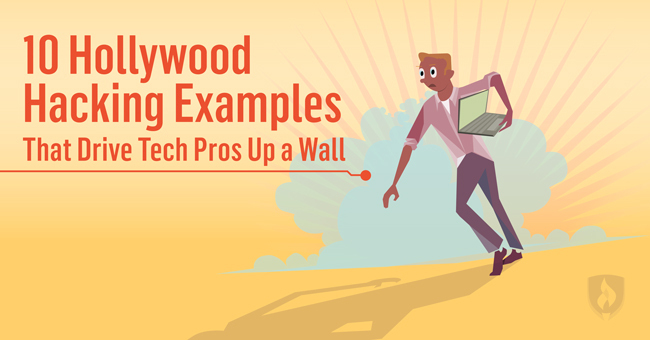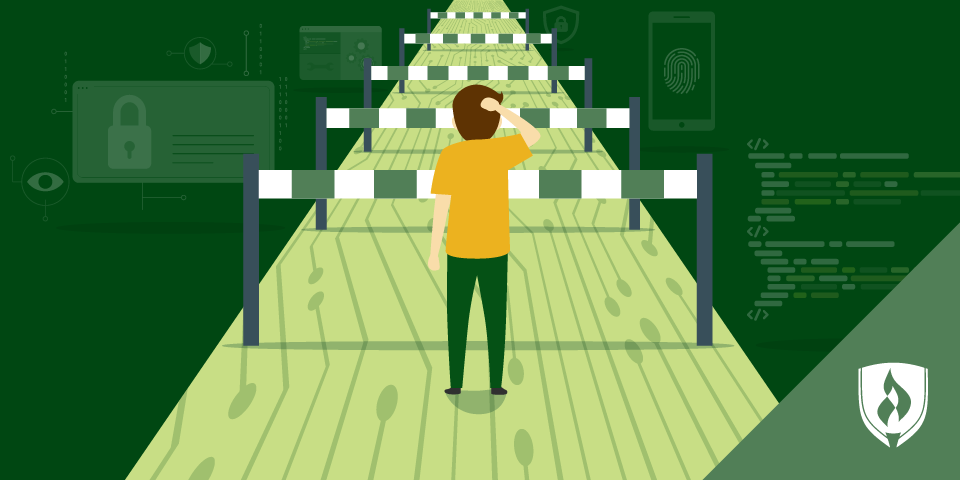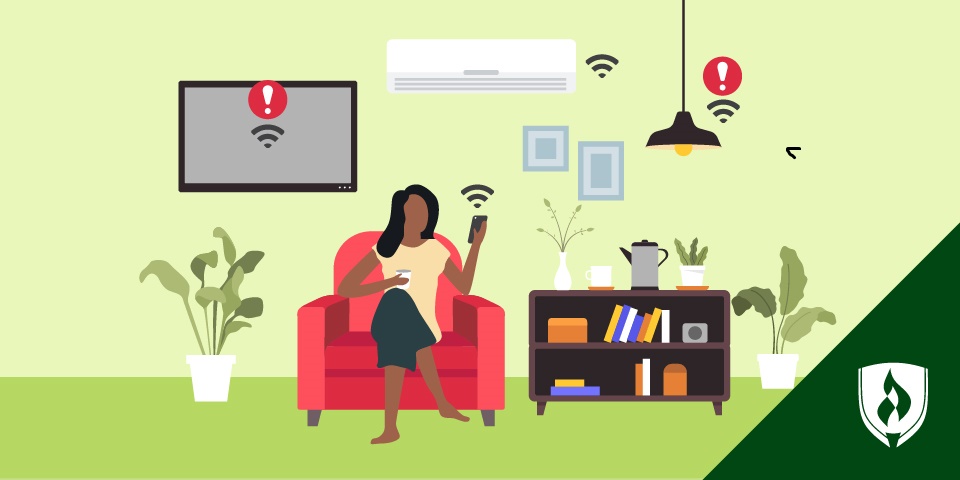
Exploding 18-wheelers. Incredible high-speed chases through major cities. The White House destroyed by aliens.
You can count on Hollywood to take everything to the extreme. Hacking, as well as computer technology in general, has been the subject of some laughably loose interpretations over the years (did you know the best hackers wear leather pants and rollerblade? Me either!)
While Hollywood hacking portrayals have improved substantially, there are still plenty of tech tropes still floating around that cause people who know better to shake their head in disbelief. With the help of tech professionals, we’ve identified some of the more egregious examples and explain the reality behind each.
Hollywood hacking examples
1. The “Zoomhance”
How it looks in Hollywood: The license plate of a suspect car is caught on grainy video camera footage, but impossible to read. With a few keystrokes, the hero of the show has zoomed in on and digitally enhanced the plate to be perfectly legible. The hero will then sit back in their chair, crack wise with a pun-filled one-liner as the next scene depicts the bad guy in handcuffs.
The reality: “There’s a limit to continuously zooming and “enhancing” a photo,” says Kerstyn Clover, a security consultant at SecureState. “It’s an amusing example of people thinking computers, pixels, and digital cameras are run on magic.”
The “zoomhance” combination of zoom and enhance portrayed in Hollywood is the source of countless wasted hours for graphic designers forced to explain why they can’t take a grainy, low-resolution source image and “enhance” it into something of professional quality. It’s true that there are methods to improving the clarity of an image, but these methods can only do so much (not to mention the legal headache of a prosecutor using enhanced or digitally altered images as evidence).
2. Impossible timing
How it looks in Hollywood: A protagonist (or 11 of them) are looking to execute a massive heist and the timing of their caper is incredibly tight. Luckily, the one hacker of the group will be able to disable all of the security systems in their way over the course of a three minute span.
The reality: “The biggest flaw is time,” says tech entrepreneur Chris Hood. “No one can hack into a system in a matter of seconds. Even with all of the tools and resources at your disposal it often takes hours, days or weeks before someone successfully gets account access information and gets in.”
Even experienced hackers need time to work their way into relatively unsophisticated networks; so taking on a massive heist target — or better yet, a large government site — in a matter of minutes is absolutely absurd. Chalk it up as an opportunity for screenwriters to inject suspense into an activity that looks downright boring to most people.
“The biggest flaw is time. No one can hack into a system in a matter of seconds."
3. Health technology as a weapon
How it looks in Hollywood: Our heroes are just about to make their escape, but as they round the corner they come face-to-face with the movie’s antagonist who has them held at gunpoint. Luckily, their tech-savvy teammate back at home base has somehow hacked the bad guy’s pacemaker; killing him from afar.
The reality: It’s not unheard of for healthcare technology to fall prey to hackers, but this is a bit over-the-top. True, the Internet of Things has certainly added a layer of connectivity to devices and objects in our lives but we’ve yet to reach the point of dramatically exploding hearts with the click of a button.
4. Virtual reality hacking!
How it looks in Hollywood: Our fearless hacker hero finally gains access to a secured system and find himself walking through a virtual maze straight out of an early first-person shooter video game trying to find files.
The reality: “You don’t ‘surf’ in (virtual reality) and hack into a system,” says James Goodnow, an attorney specializing in cybersecurity. “Hackers are more likely to ‘surf’ your social media sites, looking for things like the names of your kids or your school’s mascot for clues in gaining access to your sensitive passwords.”
This is pretty simple — the vast majority of computer interfaces are pretty easily recognizable; whether it’s a simple command line or something more closely resembling the style of Windows. No need for an elaborate maze.
5. Nonsense jargon
What it sounds like in Hollywood: Stumped with a minor technological roadblock, the resident computer whiz offers up a wonderful piece of technobabble while pushing their glasses up, “Oh? That’s easy. I’ll just re-route the encryption mainframe to our teraflop RAM with Java.”
The reality: He may as well have said, “Oh? That’s easy. I’ll just flim-flam the dog pyramid to the bicycle heart.”
For most viewers, technical jargon is greeted with a general shrug as long as it doesn’t sound completely out of place. This practice seems forgivable from the perspective of a screenwriter or producer, but the lines stick out like a sore thumb to the technologically fluent.
6. Typing speed
What it looks like in Hollywood: In the process of doing some Hollywood Hacker magic like sabotaging a pacemaker, our onscreen hacker appears to be typing at a rate approaching ten thousand words per minute.
The reality: Hacking doesn’t really require a frenzied typing pace; many hacks are executed by readymade tools or scripts that automate a lot of the work. That said, furious typing does seem to give the impression they’re working hard to most people — try it next time you hear your boss coming around the corner.
7. Oddly specific visual representations
What it looks like in Hollywood: Inexplicable progress bars that say something like “Hacking status: 40%” or “Copying secret data.” Basically anything that looks vaguely futuristic and shows a visual representation of a file being stolen or unlocked.
The reality: “The truth of the matter is that most ‘hacking software’ in the real world — Nmap, Metasplot, etc., are open-source apps with either nonexistent GUIs or the dated-looking type of graphics commonly found in open source software,” says Jon Weber, cybersecurity consultant and founder of Marathon Studios.
A hacker deciding to create a progress bar or an elaborate visualization of what their software is doing just doesn’t make much sense. If the visualization came from the entity being hacked, the person who made it has a lot of questions to answer. Primarily, “Why the heck are you making a visualization instead of fixing the security issue you’ve clearly already found?”
8. Password psychoanalysis
What it looks like in Hollywood: Our hacker hero is trying to access a password-protected account. After a moment of consideration he recalls the account owner’s love of rock music band Metallica and, within seconds, correctly guesses their password: “EnterSandman.”
The reality: “If [that] works it’s because that person is the most one-dimensional person in the world and uses neither numbers nor special characters,” Clover says. “It’s far more common to find a password written on a sticky note, or that it’s one of the top 10 passwords like ‘password’, ‘baseball’, ‘dragon’ or ‘qwerty’.”
The concept being portrayed is true in that hackers will gather personal information for clues to password or account information. However, the ability to quickly pull a perfectly correct password from small context clues is very unrealistic. Instead this personal information can be useful in an indirect way — finding answers for lost password security questions like, “What’s the name of your first pet?”
9. More monitors = better hacker
What it looks like in Hollywood: An elite hacker working furiously at a workstation with upwards of five monitors (half of which display incomprehensible green text on a black screen). If you’re lucky they might even have multiple keyboards!
The reality: Hollywood has always been a subscriber to the idea that more is better, but in this case it’s a bit of a stretch. Clover says that while studies show productivity can increase with more monitors, most people are just fine with a laptop screen. That’s not to say there aren’t a few hackers working with 6 screens, but it’s certainly not typical or even necessary.
“I know of zero databases that you can input ‘white male, 30 years old, green eyes, drives a white van’ and get actual useful hits.”
10. Incredible database searches
How it looks: TV detectives search crime database for a few basic characteristics and instantly return with a pinpointed search that leads them straight to the next step in cracking a case.
The reality: “I know of zero databases that you can input ‘white male, 30 years old, green eyes, drives a white van’ and get actual useful hits,” Clover says. “Definitely not within 30 seconds, and certainly not without things like processing paperwork and warrants.”
Yes, large police databases exist, and yes, you can search them. But like any database, the quality of your results are going to depend on your search criteria. You may be able to narrow down your focus with relatively broad searches — but the results for these would still have hundreds or thousands of potential matches that need investigating. Skipping the investigative legwork — and countless dead ends — police would find doing a realistic search is understandable from an entertainment standpoint, but if you’re going to cut corners why even show the search?
Back to reality
These are just a handful of the Hollywood hacking and technology tropes littered throughout popular culture. The truth of the matter is that hacking can have incredibly serious consequences. With so much at stake, it’s not hard to understand why the Bureau of Labor Statistics projects employment for information security analysts to grow 18 percent through 2024, more than double the average for all occupations. Learn more about careers in cyber security in our article, "5 Fascinating Infosec Jobs That Help Combat Cybercrime."
RELATED ARTICLES:




